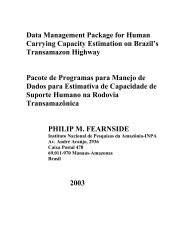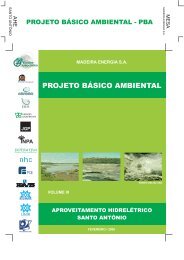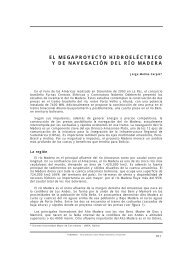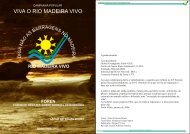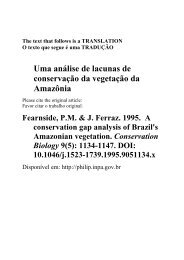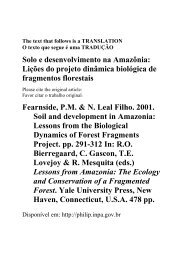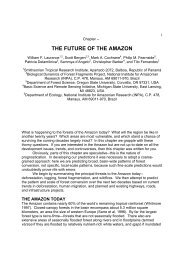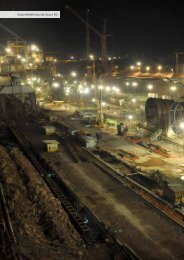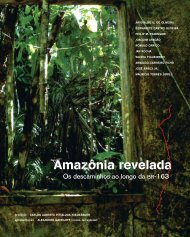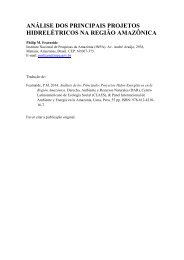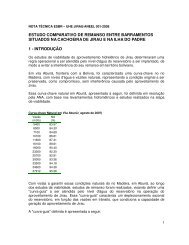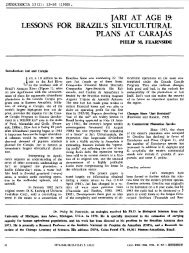Jari officials say <strong>the</strong> size of <strong>the</strong> depositcould supply <strong>the</strong> mining operation aJ <strong>the</strong>1980 extraction rate for 250 years,although <strong>the</strong> extraction rate is expectedto be increased in 1982 according to <strong>the</strong>company 17 • The small disturbance of<strong>the</strong> current operation could <strong>the</strong>refore beexpected to increase tremendously as extractionproceeds through <strong>the</strong> comingtwo centuries. The problem of reclaiming<strong>the</strong>se much larger areas will <strong>the</strong>reforeeventually have to be faced.Environmental RisksSilvicultureThe size at which replacementof natural forest with plantationswould provoke significant widerenvironmental effects is unknown, butprobably large in comparison with Jariitself. Reduced rainfall is <strong>the</strong> macroecologioaleffect most closely tied to deforestationin general (Salati et al., 1978;<strong>Fearnside</strong>, 1979). Increased severity of<strong>the</strong> dry season is a greater reason forpreoccupation about deforestation thanare decreases in annual rainfall totals.J ari's silvicultural plantations could beexpected to have less impact than <strong>the</strong>Amazon region's fast-growing areas ofcattle pasture, but would have more thanland uses which maintain intact rainforest canopy cover. Transpiration islargely a function of leaf area, implyingthat <strong>the</strong> transpiration potential of <strong>the</strong>plantations is less than that of rain forest.Evapotranspiration, mostly transpiration,has been found to account for approximatelyhalf of <strong>the</strong> water vapor generatingrainfall between Bell!m and Manaus (VillaNova et al., 1976; Salati et al., 1978).Large-scale modification in <strong>the</strong> evapotranspirationpotential could <strong>the</strong>refore beexpected to cause similar changes in rainfallfor <strong>the</strong> region. Precipitation recordsfor rain gauges maintained by Jari atMonte Dourado since 1968, and at o<strong>the</strong>rlocations in <strong>the</strong> silvicultural area since1970, 1971, 1974, and 1975, do notreveal any significant trends in total rainfall,or in such dry season severity indicatorsas number of days of rain in eachof <strong>the</strong> dry season months, minimumnumber of days of rain in any month,and minimum rainfall in any month. Thetime sequence is, however, too short toallow conclusions.Risk of any eventualclimatic effect is minimized by <strong>the</strong> largeareas which must be converted beforeany measureable change is provoked.Jari's area is small in comparison with<strong>the</strong> 3.5 million ha of cattle pastures estimatedto exist in Brazil's Legal Amazonby 1978 (Serrao et al., 1979) and <strong>the</strong>336rapid incr·eases in cleared areas since thattime (<strong>Fearnside</strong>, 1982). Beyond Jariitself, probable limitations on <strong>the</strong> spreadof large silvicultural operations in Amazoniawould include how much of <strong>the</strong>Amazon is suitable for this kind ofplantation, and how much plantationarea would be needed ·to supply projectedmarket demands (not to imply that allmarket demand should be supplied orthat all suitable areas should be used).It is well to remember that macroecologicaleffects are generally cumulative innature, being <strong>the</strong> combined result ofmany smaller strains on <strong>the</strong> system, noneof which is sufficient in itself to provoke<strong>the</strong> change.Pulp MillWater pollution frompulp mill is treated by filtering solidsludge, followed by holding <strong>the</strong> effluentfor 16 days in a series of 1 m deepconsequent increase in <strong>the</strong> risk of pollutioneffects. Although <strong>the</strong> 2000 m 11 /second average discharge of <strong>the</strong> JariRiver (Lang, 1979: 63) would appearto dwarf <strong>the</strong> effluent inputs, <strong>the</strong> headof <strong>the</strong> Brazilian Navy station at <strong>the</strong> sitesays at least one fish die-off has occurreddownstream of <strong>the</strong> mill. The location of<strong>the</strong> mill near <strong>the</strong> mouth of <strong>the</strong> AmazonRiver is fortunate in limiting potentialdamage were water pollution to becomea severe problem (and is also one of <strong>the</strong>many features of <strong>the</strong> Jari site not duplicablewere <strong>the</strong> project to be copiedelsewhere in Amazonia).Jari maintains a pollutionmonitoring laboratory at Monduga,which submits reports of daily measurementsof biological oxygen demand(BOD), disolved oxygen (DO) and o<strong>the</strong>rindicators to SEMA every week. SEMAalso occasionally sends its own personnelto collect samples. The Jari River isclassified by SEMA as "class 2"; applicablewater quality standards for thisMost of J ari's o<strong>the</strong>r operations, such as timber extraction for solidwood, kaolin mining, and irrigated rice, involve <strong>the</strong>destruction of natural habitats.ponds where bacteria act to degradeorganic materials. The 159 ha of pondsinclude capacity for emergency drainageof digestors, not included in originalplans. The relatively inexpensive ponds,constructed with simple earth dikes, allowmuch cheaper pollution treatment thanwould be possible in temperate zoneswhere covered concrete tanks are neededto maintain water at <strong>the</strong> required 300Ctemperature. In late 1980, Brazil'sSpecial Secretariat of <strong>the</strong> Environment(SEMA) took <strong>the</strong> additional precautionof requiring a fur<strong>the</strong>r enlargement of <strong>the</strong>pond area, since <strong>the</strong> ponds were nearlyfull. The enlarged ponds are underconstruction (P. Nogueira Neto, personalcommunication, Feb. 1981).Effluent, a brown liquidwith a distinctive odor (Table II), is releasedinto <strong>the</strong> Jari River at <strong>the</strong> riverbottom (about 18 m deep). An 80 emtide at <strong>the</strong> mill site in Monduga causeswater to flow upstream each day as <strong>the</strong>tide comes in, restricting effluent releasetimes to <strong>the</strong> hours when water is movingat its maximum rate downstream. The 1.1ms/second average discharge is <strong>the</strong>reforeconcentrated into much larger effluentpulses when released into <strong>the</strong> river, withcategory call for a BOD/ 5 days at 20°Cof 5 mg/ 1 or less, and DO of at least5 mg/1 in any sample (Brazil, Ministeriodo Interior, SEMA, 1976: 21).O<strong>the</strong>r OperationsMost of Jari's o<strong>the</strong>roperations, such as timber extraction forsolid wood, kaolin mining, and irrigatedrice, involve <strong>the</strong> destruction of naturalhabitats. Some, such as rice, involve <strong>the</strong>use of chemicals which can affect ecosystemsbeyond those altered directly inimplanting <strong>the</strong> production system.Jari's buyers are seekinggovernment approval for several projectsattempted by Ludwig but blocked byregulatory impasses. These include constructinga hydroelectric dam and importing a second pulp mill ( Veja, 13 de janeiode 1982). O<strong>the</strong>r projects contemplatedby Ludwig, such as expanding <strong>the</strong>industial sector to produce paper on <strong>the</strong>site, might eventually also be realized if<strong>the</strong> various projects already in operationprove profitable.Environmental risks of<strong>the</strong> various projects depend very muchNOV- DEC 1982, VOL. 7 NQ 6 IIVERDffiDR
on how large <strong>the</strong>y become. Jari's size( 305 such estates would occupy Brazil'sentire Legal Amazon) means that potentialimpacts at <strong>the</strong> local level meritcareful monitoring.General ConclusionJari's management policymust strive for indefinite sustainability,even though this implies higher currentoutlays. Among <strong>the</strong> preconditions requiredfor sustainable management of <strong>the</strong>silviculture operation are: additionalplantations to supply <strong>the</strong> fuel and pulpcurrently derived from native forest, anextensive research and monitoring effort,and <strong>the</strong> replacement of nutrients removedin harvested biomass. These changes donot assure Jari's future, although longterm prospects are clearly bleak without<strong>the</strong>m.Silviculture, irrigatedrice, and o<strong>the</strong>r sectors of Jari face biologicaland technical difficulties, as wellas environmental risks. Hopefully informeddebate on <strong>the</strong>se issues will take placewith an eye to minimizing <strong>the</strong> probabilityand potential impact of possible problems,and with <strong>the</strong> objective of contributingto wiser choices of developmentpatterns offering a sustainable basis forserving human needs in <strong>the</strong> region 1 s.ARCOCENACNPqBMBRAPAFAOINCRAINPAIRISBPCSBMAGLOSSARYAtlantic Richfield Corporation.Centro de Energia Nuclear naAgricultura (Center for NuclearEnergy in Agriculture), Piracicaba,Sao Paulo.Conselho Nacional de DesenvolvimentoCienti/ico e Tecnol6gico(National Council for Scientificand Technological Development),Brasfiia.Empresa Brasileira de PesqulsasAgropecudrias (Brazilian Enterprisefor Agriculture and CattleRanching Research), Brasilia.Food and Agriculture Organizationof <strong>the</strong> United Nations, Rome.Instituto Nacional de Coloniza,iioe Reforma Agraria (National Instilefor Colonization and AgrarianReform), Brasilia.Instituto Nacional de Pesquisasda Amaz;bnia (National Institutefor Research in <strong>the</strong> Amazon),Manaus, Amazonas.IRI Research Institute, New York..Sociedade Brasileira para o Progressoda Ciencia (Brazilian Societyfor <strong>the</strong> Progress of Science),Slo Paulo.Secretaria Especial do Meio-Ambiente(Special Secretariat of <strong>the</strong>Environment), Brasflia.NOTES1. Jari Florestal e Agropecubia, Ltda. andCaulim da Amazonia S/ A are now beingintegrated into <strong>the</strong> firm Companhia doJari. The third Ludwig firm, Sao RaimundoAgropecuiiria Ltda., is not included in <strong>the</strong>sale, although negotiations are underway(Veja 27 de janeiro de 1982: 92).2. This figure is J ari's last claim underLudwig. Jari's <strong>new</strong> owners also claim 1.6million ha (A Critica, 13 de janeiro de1982: 2), but have apparently so far onlyreceived assurances from <strong>the</strong> Brazilian governmentthat 900,000 ha are <strong>the</strong>irs, with<strong>the</strong> "possibility of expansion" to 2 millionha (Veja, 13 de janeiro de 1982).3. Jari's reported cash deficit in 1979 wasUS$ 150 million, <strong>the</strong> US$ 70 million inrevenues (pulp + rice) being offset byoperating costs of US$ 110 million, constructioncosts of US$ 50 million, and debtservice costs of US$ 60 million. In 1980 <strong>the</strong>deficit was US$ 14 million, revenues ofUS$ 9(} million being absorbed by operatingcosts in <strong>the</strong> pulp project of US$ 10 million,operating costs in <strong>the</strong> rice project of US$10 million, construction costs of US$ 20million, and debt service of US$ 64 million(Kinkead, 1981). O<strong>the</strong>r reports indicate<strong>the</strong> project lost US$ 80 million in 1980on an operating budget of US$ 250 million(Brooke, 1981).4. Proceeds from <strong>the</strong> sale will go to <strong>the</strong>Fundacao Daniel Ludwig para a Pesquisado C~ncer (Daniel Ludwig Cancer ResearchFoundation) in Sao Paulo, plus a percentageof dividends distributed to stockholdersthrough <strong>the</strong> year 2021: 5% for 10 yearsbeginning in 1987,4% for <strong>the</strong> next 10 years,and 3% for <strong>the</strong> last 15 years (Veja, 13 dejaneiro de 1982). Note: <strong>the</strong> total debts of<strong>the</strong> project have been reported to be US$350 million (Veja, 16 de dezembro de1981: 77), or US$ 170 million in additionto <strong>the</strong> remaining balance of <strong>the</strong> pulp millloan.5. From 5-12 November 1980 we observedcommercial and experimental plantationsof Gmelina arborea, Pinus caribea var.hondurensis, and Eucalyptus deglupta, andexperimental plantations of various o<strong>the</strong>rspecies. Also visited were <strong>the</strong> nursey, pulpmill and power plant, mill effluent treatmentponds, wood transport and storagefacilities, laboratories for soil, pulpingresearch, and pollution control, herbaria,entomological and wood collections ando<strong>the</strong>r laboratories and technical offices.O<strong>the</strong>r sectors observed were <strong>the</strong> vdrz;earice project, kaolin mine, water buffaloherd, beef cattle herd (in pastures in youngpine plantations), and native forest extractionoperations, as well as <strong>the</strong> native forestand <strong>the</strong> Jari and Araiolos Rivers. We alsovisited <strong>the</strong> project in August 1978.6. 60-90% standing crop ~ 20 em DBH. Inover 400 species present, 230 are of sameuse. Of usable species, 82-86% can beutilized with Gmelina for pulp (Woessner,1980a).7. Various growth rates have been reported,but an average figure has apparently neverbeen disclosed by <strong>the</strong> company. Kalish(1979) reports that "<strong>the</strong> exact growthrate was not disclosed by J ari foresters,but it is believed to be in <strong>the</strong> range of25-35 m' /ha/year for Gmelina and slightlylower for pine." One estimate, also madewithout benefit of production figures from<strong>the</strong> company, anticipated a mean yield of25 m'/ha/year for Gmelina, and 15 m 1 /ha;year for Pinus. (Rollet, 1980: 8), and reportedthat 35 m 1 /ha;year were "expected"from Eucalyptus (Rollet 1980: 14). AlthoughJ ari staff declined to estimateaverage yields for us as well, <strong>the</strong>y statedthat yields obtained on good soils were35 m• /ha/year for Gmelina, 25 m' /ha/yearfor P. caribaea, and very approximately40 m' /ha/year for E. deglupta. It is worthnoting that <strong>the</strong>se E. deglupta yields aremuch higher than those reported for plantationsin o<strong>the</strong>r tropical countries. In <strong>the</strong><strong>Philip</strong>pines, for example, a maximum ofonly 25 m' /ha;year has been obtained (Tagudar,1974 cited by Johnson, 1976: 208).Woessner (1980a) gives maximum yieldsat rotation age at Jari of 42 m' ;ha/yearfor B. deglupta 38 m' /ha/year for Gmelina,and 25 m' ;ha/year for P. caribaea, butobserves that "on less optimum sites <strong>the</strong>yields may be reduced by 'h". Actually,on <strong>the</strong> least optimal sites <strong>the</strong> economicyield can be considered to be zero, since20.7% of <strong>the</strong> plantation is reportedly "notmanaged" mostly due to poor soils (T.H.Svendsen and S. Lassen, personal communicationJuly 1981). Jari's problem is thatrelatively little of <strong>the</strong> area is optimal, andit can ill afford to base calculations on<strong>the</strong> best possible yields. Average yields aremuch lower than <strong>the</strong> approximately 40m'/ha/year originally anticipated by Ludwigfor <strong>the</strong> Gmelina he expected to use for<strong>the</strong> entire plantation: <strong>the</strong> areas now plantedwith P. caribaea instead of Gmelina canyield a maximum of 63% of this figure,probably yielding less over most of <strong>the</strong>area, while Gmelina and E. deglupta, al·though capable of achieving <strong>the</strong> expectedyields on <strong>the</strong> best sites, fall far short onmore typical solis. At more representativesite indices for Gmelina on <strong>the</strong> order of21, yields are around 20 m'/ha/year (seenote 10). One report gives Gmelina yieldsfor sites of index 21 or over as 28 m' /ha/year, expected yields of 20 m 3 /ha/year forP. caribaea, and 20 m 3 /ha/year (based onexperimental plots) for E. deglupta (T.B.Svendsen and S. Lassen, personal communicationJuly 1981). One earlier estimate,also made without benefit of productionfigures from <strong>the</strong> company, anticipated amean yield of 25 m 3 /ha/year for Gmelinaand 15 m 1 /ha;year for Pinus (Rollet, 1980:8), and reported that 35 m'/ha/year were"expected" (Rollet, 1980: 14). Very approximately,present yields on <strong>the</strong> order ofhalf <strong>the</strong> original expectation seem probableover <strong>the</strong> estate as a whole.8. According to Jari technical personnel,company laborers earn (Nov. 1980) Cr$114;day when calculated at 30 days/monthpaid for 13 months/year to include <strong>the</strong>extra month's salary standard in Brazil.They also receive production incentivesaveraging 30% of <strong>the</strong>ir total pay (butranging up to 300%). This gives a totalof Cr$57,798/year. Additionally, <strong>the</strong> companyprobably pays <strong>the</strong> standard benefitsin Brazil: 22.33% in health insurance andsocial security, 8.33% in government medicalassistance, and 8.33% for disabilityleave allowance. These would increase <strong>the</strong>cost to <strong>the</strong> company to Cr$75.132/worker/year, or Cr$262.70/day worked using a286-day year (discounting Sundays and aone month paid vacation), or US$4.24/worker/day worked at Cr$62/US$ (Nov.1980).ln7EI?DEni:IR NOV- DEC 1982, VOL. 7 N9 6337



